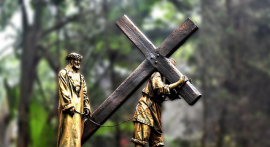On Oct. 26 in 2008, the Lutheran Church in Korea (LCK) celebrated the 50th Anniversary of Lutheran Mission in Korea. By 2008 the LCK had established a total of 41 congregations with about 5.000 baptized members. Compared to other denomination in Korea -- especially the Presbyterian Church, which has a history of 120 years and some 7.5 million members -- the LCK is small denomination in Korea.
The Lutheran work was, from the very beginning, under the shadow of Korean Protestantism which is predominantly reformed in theology with a Pentecostal ferment, non-liturgical, and with little emphasis on the Holy Sacraments. Through the Presbyterian and Methodist Churches, a certain image of Christianity and of the Church had been firmly fixed. Under these circumstances, “Lutheran” was very unfamiliar and strange. People, both Christians and non-Christians, often hesitated to approach a Lutheran church. In some extreme cases, Christians thought of “Lutherans” as a heretical sect and another Catholic church. This is because of Lutheran liturgy. The liturgy quite strange for Christians and non-Christians alike in Korea (except the Catholic Church and Anglican Church).
Naturally, the question of “Lutheran liturgy” is raised: Some Lutheran pastors argue that Lutheran liturgy should be transformed into something that is appropriate for Korean Christianity. They assert that like the worship of the other protestant denominations, Lutheran liturgy should be simplified, such as hymns, prayers, and sermon. They called it the process of the indigenization of LCK. On the other hand, the others argue that Lutheran liturgy is one of the most important aspects of the Lutheran identity. They say: No Liturgy, No Lutheran.
This question is also imperative for Korean congregations in LCMS. Many students and immigrants came to the U.S. each year. Regardless of religion and denomination, most of them want to be a member of the Korean Church in U.S. to be immersed in Korean culture. The Korean Church in the U.S. is the only place that seems most like home for recent immigrants, as well as the community of the faith. But the Lutheran church is quite strange for them, because they were already familiar with the situation of Churches in Korea.
Historical Context
Luther's attitude toward the liturgy corresponds to the conservative and constructive nature of his Reformation. Thus it is more accurate to speak of Luther's modification, rather than his abolition of traditional worship.
In his Babylonian Captivity of the Church (1520), Luther criticizes the Medieval Mass. Of particular note are his violent attacks on the Mass as a sacrifice and good work, private masses, and the silent recitation of the canon. However, Luther did not remove as many of the sacrificial elements from the Mass as it is sometimes stated. For example, he retained the Gloria, prayers, Sanctus, Benedictus, Hosanna, Agnus Dei, and Nunc Dimitis.
In 1523 Martin Luther reformed the late medieval liturgy of the Mass. He called it Formula Missae or the Latin Mass. Luther viewed Formula Missae as an experimental, interim work: “We must dare something in the name of Christ!”(LW 53:20). Luther used the purity of the Gospel (the doctrine of justification) as his main criteria for reforming the late medieval Latin Mass. However, Luther states: “It has never been our intention to abolish the liturgical service of God completely, but rather to purify the one that is now in use. . ."(LW 53:20).
Luther also adapted secular music in composing hymns. It means Luther tried to stay as close as possible to the German folk-song. However, continuity with the past is retained. Thirty-two of his thirty-six hymns are adaptions of pre-Reformation hymns. Luther’s criticism of existing ceremonies stems not from indifference to liturgical forms, but from a pastoral desire for consciences cramped and burdened by excess.
Application for Today
Despite the ardent attacks of secularism and ideology, many Lutherans clung to the forms of worship they had inherited from Martin Luther. For them worship was “the Gospel in action”. The proclamation of God’s word and the sacramental parts of the liturgy gave expression to this. Therefore, we should conserve the traditional Lutheran liturgy, because it is an important aspect of expressing Lutheran identity, as well as to unite Lutherans all over the world.
On the other hand, we should also develop Korean Lutheran liturgy reflecting Korean culture, sentiment, and even the existing worship style in Korean Christianity, The image of Korean church is characterized by the following: It is the active, vibrant, committed, self-sacrificing Christians who flock into the church on each Sunday morning, Sunday evening and Wednesday evening; attend the early dawn prayer meeting, the Friday “all-night” vigil gathering. And the circuit meeting; and visit the prayer houses in the mountains. It means Lutheran members in Korea often want the active worship.
Therefore, Lutheran Church in Korea should be more interested in conserving the traditional Lutheran liturgy, as well as developing Korean Lutheran liturgy. Practically, how is it possible? For this, my suggestion is that in Sunday morning, we worship with traditional Lutheran liturgy, in Sunday evening and Wednesday evening, we worship with more active and contemporary liturgy. I think this is best way not only to indigenize Lutheran liturgy, but also to conserve of Lutheran Liturgy.

Reverend and Doctor Jin O. Jeong is an assistant pastor for Korean congregation at Zion Lutheran Church, Belleville, IL. He graduated from Luther University and received a Ph.D from Yonsei University. He was also a Research Fellow at Hebrew University and Visiting Scholar at Yale Divinity School. Tel: 618-920-9311 Email : jjeong@zionbelleville.org

















